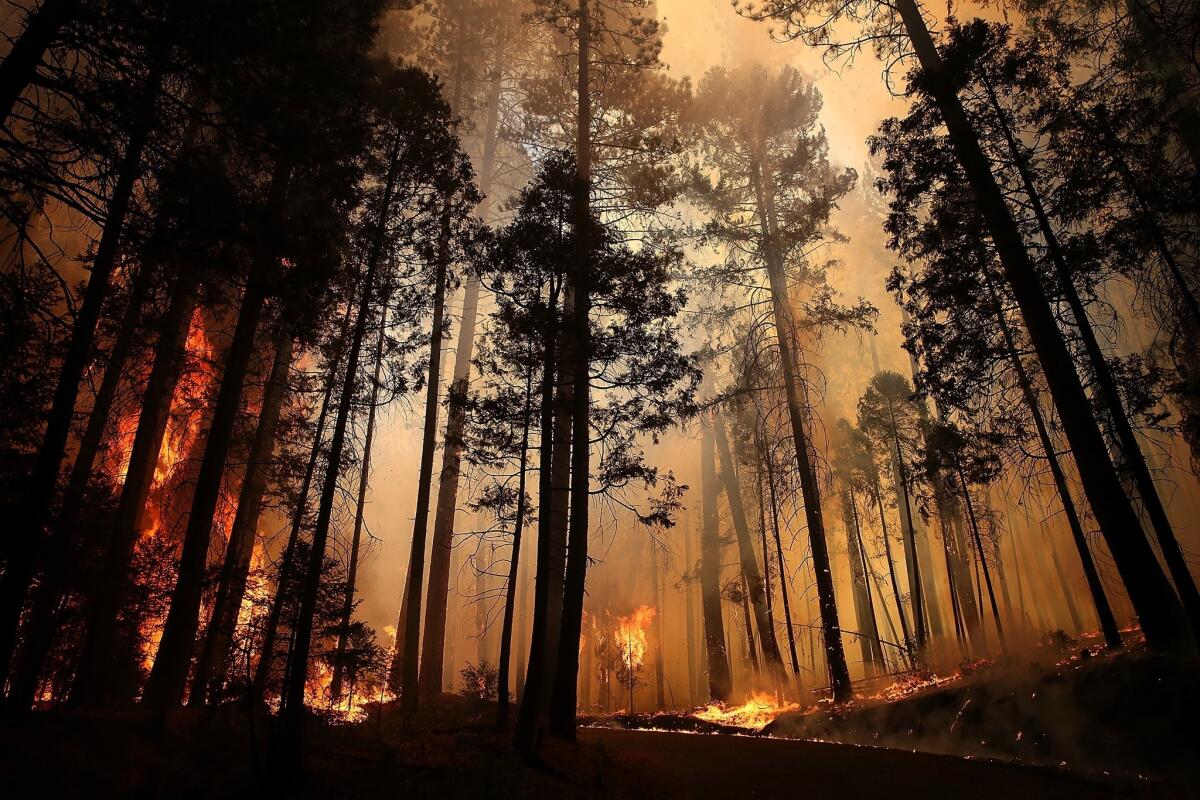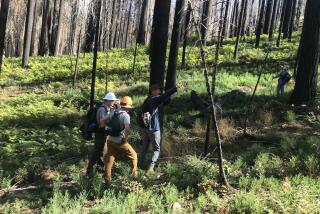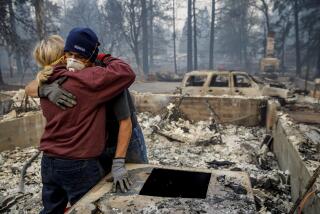Opinion: California’s clear-cutting project in the Rim fire area is setting up the region for another tragedy

During hot, dry and windy conditions last November, the Camp fire devastated the towns of Paradise and Concow in the northern Sierra Nevada, ultimately claiming at least 85 lives and destroying thousands of homes. The tragedy was a wake-up call regarding the increasing risks to vulnerable communities stemming from the human-caused climate crisis.
But forest fire behavior is complex, and multiple factors affect fire severity. In addition to high regional temperatures and aridity, the Camp fire was fueled by persistent forest mismanagement.
After the Butte Complex fire of 2008 that burned the forest just east of Paradise, there were years of extensive post-fire clear-cutting and artificial planting of dense tree farms on private and public lands. The Camp fire burned rapidly and intensely through these heavily post-fire logged areas as it spread toward Paradise, consistent with the findings of scientific research establishing that such post-fire management tends to increase future fire intensity. Post-fire logging leaves behind kindling-like “slash debris” (branches and treetops) and spreads combustible non-native weeds like cheatgrass. In addition, the croplike tree farms planted after clear-cutting generally burn more intensely when fires recur.
Even in the face of that research and those lessons, Gov. Gavin Newsom’s administration is partnering with President Trump’s team to clear-cut and then plant tree farms on several thousand acres of national forest lands in the Rim fire area, which scorched more than 250,000 acres in and around Yosemite National Park in 2013. Adding insult to injury, the Newsom-Trump project utilizes $28 million of federal Housing and Urban Development funds that were supposed to be used for community disaster recovery and rebuilding.
The state of California, in conjunction with the U.S. Forest Service, requested these funds from HUD based on the claim that trees would not naturally grow back in the Rim fire, and that clear-cutting and artificial tree planting was the only option. But now we know better — forests are naturally regenerating vigorously in the Rim fire.
This clear-cutting started over the summer and is being undertaken near the western border of Yosemite, arguably the crown jewel of the nation’s national park system. The entire scheme — misusing community disaster relief funds to subsidize widespread clear-cutting on remote public lands — is fraught on multiple levels.
As a group of U.S. Forest Service scientists observed last fall in the journal of Forest Ecology and Management, the last time the Forest Service conducted post-fire clear-cutting and created dense tree plantations in this same area, it caused “rapid fire spread and high fire intensity” during the Rim fire.
Some small towns, as well as many large resorts — each with many dozens of cabins — are in close proximity to the planned clear-cuts and tree plantations in the Rim fire, setting up the region for another tragedy like the Camp fire.
The Rim fire clear-cutting plan also exacerbates the global climate crisis. Vigorous, naturally regenerating young conifer forests actively sequester an increasing amount of carbon each year, which helps reduce greenhouse gases responsible for climate change in our atmosphere. Such forests are being clear-cut in the area right now. Moreover, the Rim fire clear-cutting plan calls for felling and bulldozing trees into giant piles in places, and incinerating them on site with accelerants, leaving large areas of scarred, barren ground.
In other locations, the plan requires felling the trees and grinding them into chips to be hauled to “biomass” power facilities, where they will be incinerated for energy production. Either way, the large amounts of carbon in these trees would be released into the atmosphere when the nation and the world can least afford additional greenhouse gas emissions, in light of the urgency of the climate crisis.
Further, damaging fragile post-fire soils with industrial logging machinery and removing most of the nutrients stored in the trees from the ecosystem likely will inhibit forest regrowth and convert some of the forest ecosystem into invasive grassland — a deplorable development that undermines the area’s ability to mitigate climate change since grass captures less atmospheric carbon dioxide than trees.
Moreover, as more than 250 scientists explained to Congress in 2015, the unique habitat that is created by mixed-intensity fires rivals old-growth forest in native biodiversity and wildlife abundance. Taxpayers should not be spending millions to subsidize the destruction of these vital ecosystems.
Newsom has an important choice to make: He can continue to partner with Trump in a project that exacerbates the global climate crisis and the risk of severe fire to rural communities. Or he can halt this misguided scheme and redirect the remainder of his HUD grant to help Paradise rebuild and adapt in a fire-safe way.
The Rim fire clear-cutting project is bad for our forests, bad for communities and bad for our climate. California’s reputation as a climate leader hangs in the balance.
Chad Hanson is a forest ecologist with the John Muir Project. James Hansen, a former director of NASA’s Goddard Institute for Space Studies, directs the Climate Science, Awareness and Solutions program at Columbia University. They and others recently filed suit to halt the Rim fire clear-cutting project.
More to Read
A cure for the common opinion
Get thought-provoking perspectives with our weekly newsletter.
You may occasionally receive promotional content from the Los Angeles Times.






